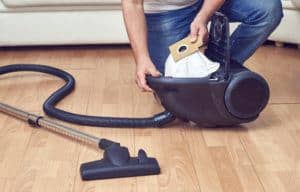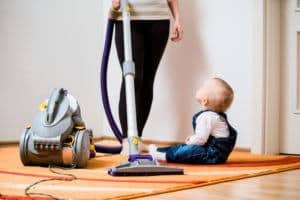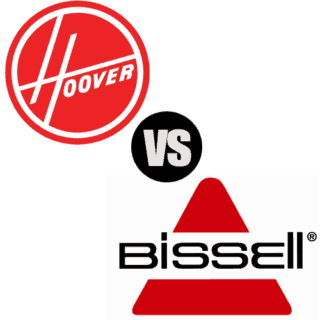
Bag vacuum cleaners tend to be the better option for households that need a guaranteed improvement in air quality. These vacuums tend to produce less overall dust, remove more contaminants from floors, carpet, and upholstery, and come with features that can supplement specific needs.
Bagless vacuum cleaners are a good all-around choice for homes that want cleaner floors and a guaranteed experience. They may need more trips for dirt disposal, but they also tend to have lower ongoing maintenance costs. Many bagless models are beginning to compete with their bag competitors in terms of air quality improvement as well.
No matter what your budget may be, the bag vs bagless vacuum cleaner debate offers several choices that can improve your home right now. Compare each to find the features you need and you’ll find that the vacuum you purchase today will be a great investment now and into the future.
How to Find the Best Bagged or Bagless Vacuum for Your Home
There’s a good chance that you’ve had a vacuum cleaner sales person visit your door at some point.
Some of them are nice and don’t try to push their products onto you. Others, however, want to make a mess in your home, show you how awesome their vacuum is, and it takes a supernatural act to get them to leave.
This is the same relationship that people have with the dirt and debris in their home. The dirt moves in and decides to stay there. It challenges you to do something about it. Sometimes, it may even trigger allergic reactions or physical problems, such as asthma, with its presence.
In the bag vs bagless vacuum cleaner debate, you have plenty of options available to you so that the dirt and debris can be forced to leave. Some vacuums are nice about it and will quietly go about their business so that you have a cleaner home. Others are loud and noisy and create a bigger mess than when you first started.
How can you tell if you’re looking at the best bagged vacuums or the best bagless vacuums? Here are the key points that you’ll want to consider as you go about the process of shopping in each category.
What are the Benefits of Choosing a Bagged Vacuum?

#1. There are fewer allergens and health triggers that are re-introduced to the environment. Bagged vacuums do an excellent job of keeping the items that have been vacuumed from the carpet or hard floor from escaping. Many offer a sealed system, some with HEPA filtration, that provides a noticeable difference in the cleanliness of the home. If you are using a vacuum bag which has multiple layers to it, then removing the fine dust from a floor and then disposing of it are simplified.
#2. You have less mess when disposing of dirt and debris. Have you ever tried to dump out the container of a bagless vacuum? Unless you have an empty trash bag or a deep trash can, there will be dust flying out everywhere when you dump the stuff out. Then, even if you do get everything where it should be, there’s a good chance that the surface of your trash bag is going to be lined with dust. Anything you place into that bag will cause more dust to go into the air. With a vacuum bag, you can remove it, toss it, and then forget about it.
#3. Users are exposed to much less dirt and debris while working. If you have ever used a bagless vacuum, then there is a good chance you’ve come across something that sticks to the filter, the container, or the blower mechanisms. How do you remove that stuck stuff? Many choose to stick their hands in there to get rid of it, especially if it is pet fur. Then your hand gets covered in a thick layer of dust. With a bag, you can eliminate this problem almost completely. If you carefully remove a bag according to the manufacturer’s instructions, the amount of exposure is greatly diminished.
#4. These vacuums need to be emptied less often. Some bagged vacuums can handle up to 3 dry quarts of material collection for vacuuming. This is an extremely effective way to clean a carpet or hard floor, especially if you have a medium-to-large home that needs to be cleaned. Bagless containers typically hold 1.5 dry liters or less and they need to be emptied before they reach their maximum capacity for best results. That means you can vacuum faster when using a bagged vacuum in many circumstances.
#5. Many bagged vacuums include the filter in the vacuum bag. Because the filter is in the vacuum bag, the amount of actual maintenance work tends to be less than that of a bagless model. You may have the added cost of bags with this type of vacuum, but you don’t usually have the added cost of swapping filters a couple of times per year. That means when you have a full bag, you’re replacing the filter for your vacuum, and that leads to a superior level of clean for just about any floor.
#6. Some bags can seal themselves once removed from the vacuum. This feature makes it possible to almost eliminate any post-vacuuming dust exposure that may be encountered. Although some vacuum bags can be somewhat expensive, the best in this category can hold almost two pounds of debris and are created with odor-absorbing materials so there isn’t the threat of a lingering stench. Then, when you finally do need to remove the bag, the best will seal themselves closed.
What are the Best Brands to Consider When Purchasing a Bag Vacuum?
Because bag vacuums are proven technology, virtually any brand that is offered this style of vacuum can produce an excellent product that can help your home become clean. Because the design is similar, in both upright and canister vacuums, there are three key features to look at when looking for the best vacuums of this type from the best brands.
- Suction Power. With more suction, you are able to increase the amount of dirt and debris that can be sucked into the disposal bag. This also makes it easier for canister and upright vacuums to remove dirt and pet hair that tends to accumulate in the corners of stairs and along the bottom of your wall trim.
- Total Reach. This measurement is obtained by combining the length of the power cord with the length of the hose on the vacuum cleaner. If you want to be able to vacuum with fewer stops, a total reach of at least 30 feet is necessary. The best vacuums in this category will exceed 40 feet with this measurement.
- Filtration. All vacuums have some type of filtering process to eliminate or separate dust from the air flow into the bag. If you or someone in your household struggles with asthma, allergies, COPD, or some other breathing issue, look for a vacuum which features HEPA filtration and a sealed vacuuming process for the best possible results.
When looking at the best brands of bag vacuums, one tends to stand out above the rest: Oreck. These vacuums were initially built for professional or commercial use only. They were intended to be used in hotels so that a superior level of clean could be achieved. When the brand realized that professionals were purchasing their commercial vacuums for home use, they began to manufacture several models that could better serve the needs of a residential setting.
Other brands to consider within this category include Bissell, Hoover, Kenmore, and Sanitaire.
Here are our top-10 best bagged vacuum cleaners which are currently available.
What are the Benefits of Choosing a Bagless Vacuum?

#1. It is an economically viable option for those on a tight budget. Although the price of the average vacuum bag is about $2 for most manufacturers, that is a cost which adds up over time. Even if you only need to change a bag once per month, that’s an average of $24 per year that goes into vacuum maintenance. If you want odor elimination bags, you may need to triple that cost. Once you reach a maintenance price of $72 annually, you’re talking about the cost of a new vacuum. Bagless vacuums eliminate this cost altogether.
#2. There is less down time with a bagless vacuum. Both bag and bagless vacuums require some down time to dispose of the crud that has been picked up off the floor. With a bagless vacuum, you just remove the container, dump it, and then replace it to start working again. This process is much simpler than trying to get a vacuum bag to clip into the right place. Plus, if you miss the clips, the bagged vacuum can spread a huge mess everywhere. You’ll know if the container is not in its proper place on a bagless model before you get started.
#3. You can compost items from your floor with a bagless model. Bagless vacuums are one of the most environmentally friendly options that are currently available in this section of the home appliance industry. Not only do you avoid the ongoing costs of paper for the vacuum bags, but you can also quickly dump a full dirt container into your compost bin if you wish. You can recycle the debris from your home into good stuff that will make your garden grow. There is a fossil fuel cost to the plastics that are used for most containers, but the long-term savings is still better with a bagless model compared to a bagged model.
#4. Bagless vacuums allow you to empty debris on-demand. If you have a bagged vacuum cleaner, then you’re stuck with the same bag until it is full. If you have a small space to vacuum, you may find that the time the dirt sits in there allows it to begin decomposing. That creates a smell within the bag that can translate to your carpet when vacuuming. With a bagless vacuum, you can dump out the stuff you’ve vacuumed at the end of the day and never need to worry about it smelling.
#5. Cleaning a bagless vacuum is super simple. All you need to do is rinse the dust container in some water or use a wet rag to wipe it out to have a cleaner vacuuming experience. Most components on a bagless vacuum can be wiped clean. Then, once you’ve wiped the unit clean, you can dry it with a clean towel and you’re ready to get back to work. There is no longer a need to disassemble the vacuum and allow each component to air dry to maintain the vacuum. It’s a real time-saver compared to the work a bagged vacuum takes to be clean.
#6. They tend to clog less often than bagged vacuums. A bag vacuum is going to slowly lose its suction power over time. This is because of simple science. As there is less room in the bag, there is less effective suction power. Bagless vacuums do not suffer from this problem. Cyclonic technologies that have been introduced into this category allow several brands to manufacture vacuums that never lose their suction. This means fewer clogs in the hose or chamber, which results in less overall down time for the average owner.
What are the Best Brands to Consider When Purchasing a Bagless Vacuum?
Bagless vacuums are an emerging technology, even though they’ve been available to the residential market for more than two decades. It is this category where most of the innovations in vacuuming technology are taking place. Because of this, you’ll find that brands tend to focus on a specific demographic when marketing their product.
These demographics can be broken down into three specific categories.
- Budget Conscious. This is the type of bagless vacuum that gets the basics right, but provides few, if any, additional features to make cleaning easier. Brands that tend to focus on this category are Bissell, Hoover, and Dirt Devil. You’ll receive a cleaner carpet, but there may be challenges to disposing of the collected debris or limited power to the suction capacity.
- All Around. This bagless vacuum provides a solid user experience at a price that is usually between $100-$200. You’ll receive a set of accessories or tools with this type of vacuum in most instances, along with a strong suction capacity and a larger dirt container to hold debris. Many vacuums in this category have focused on debris disposal as well, limiting the amount of exposure people are required to have when cleaning their vacuum. Most brands have at least one model in this category.
- Premium. This type of bagless vacuum is intended for the households who want their carpets and floors to have a superior level of clean, no matter what the price may be. Vacuums in this category will have commercial-strength suction, an extended reach, and a plethora of features that allow users to clean every area of the home. Some models in this category work as a 2-in-1 vacuum, allowing the primary unit to be removed from the vacuum to create a handheld or stick bagless in addition to the canister or upright version. Pricing begins at $250 in this category and goes up to $600. Two primary brands stand out here: Dyson and Shark.
One of the growing trends in the bagless category is to create a vacuuming experience that is just as clean as a bag vacuum. Some brands are introducing HEPA filtration with their bagless models and are including a sealed vacuuming experience as well.
The one main challenge to this category is how the debris is removed. Most manufacturers still recommend placing a container deep into a trash bag or emptying a container outside for best results as the dust can fly out into the environment rather easily. Look for models that have improved features in the container technology for the best results in this category.
Here are our top-10 best bagless vacuums which are currently available.
We hope you enjoyed our article and that it helps you find the perfect vacuum for you and your home.


















